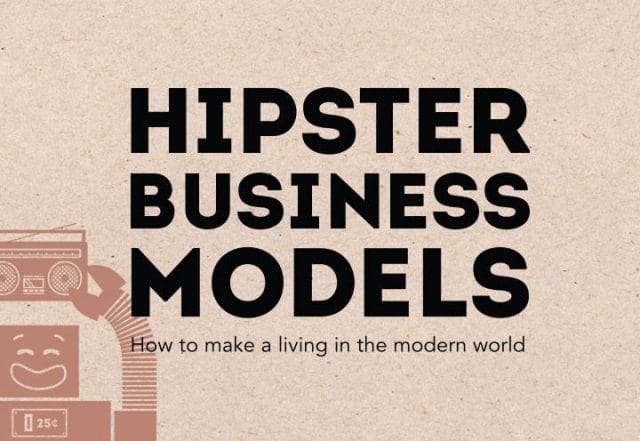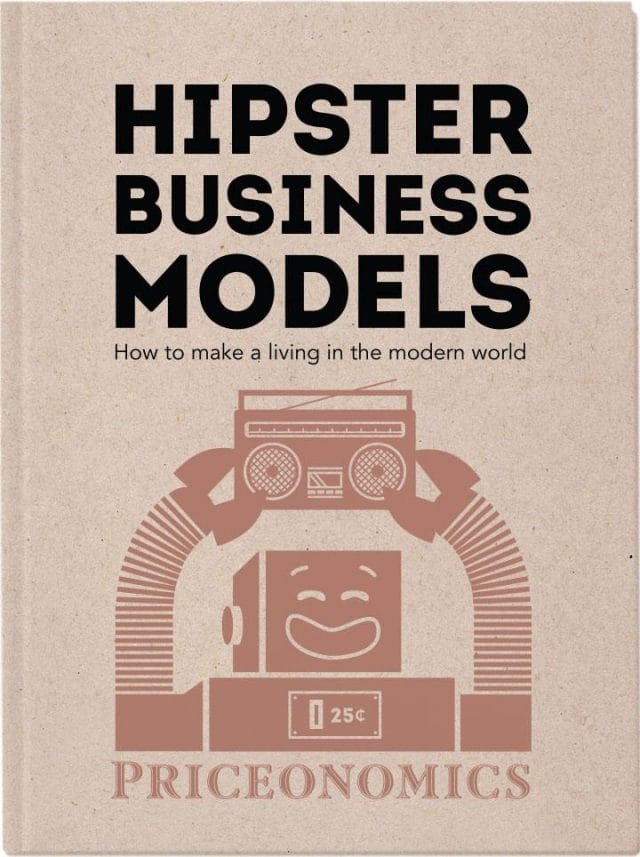We wrote a book! Priceonomics has released our second book, Hipster Business Models.
This is a book about people who come up with new ideas and, instead of screwing around, they just try them. They learn how to make things, sell them, and keep grinding — usually for years — until they get it right. They’re often ridiculed, and, in most cases, fall flat on their faces very publically somewhere along the way. But they keep pushing until they find success.
It’s a book about people who aren’t afraid to try new things. You know, “hipsters.”
Here’s the link to buy the book on Amazon → Hipster Business Models.
When we typically think of the word hipster, we think of modern society’s interpretation of the term: tight pants, fake reading glasses, beards, and irony. While making fun of these young people and their tastes may be a great way to humorously generate page views, there is more to so-called hipsters than meets the eye.
If half of the hipster stereotype is a consumer who tries to show off how cool he is based on his tastes, the other half of the stereotype is “The Maker” — the person out hawking homemade cheese, sweaters for your beard, or steel-framed bicycles. If you’re going to use the word to make a huge-ass-generalization, why not focus instead on the sheer number of supposed “hipsters” who aspire to make a living by creating things?
The Origin of this Book

Hipster or legendary Stanford professor?
When researching stories for our blog, we often talk to interesting entrepreneurs and inventors. From bike shop owners, to coffee machine inventors, to food truck proprietors, to startup founders, we’ve found that their stories consistently follow an arc:
I had this idea for something that I really wanted to exist. The problem was that I had no idea how to make it. So, I painfully learned how to make it myself. When I finally made it, it was pretty crappy, but I started trying to sell it anyway. It turned out, no one wanted to buy it. I was tempted to quit, but kept at it. I changed the product a bit. I showed it to more people. One day, the product was pretty good and people started buying it. Over time, more people started buying it. Now, it looks like I’m pretty successful to the outside world, but I still have a long way to go.
To some people, this is just how you start a company: if you have an idea you’re consumed by, you try it.
Yet we can’t help but notice that a lot of people don’t think of entrepreneurship this way. Many still think that the only way to start a business goes like this: get a patent, raise capital, hire people who know how to make the product, get the product sold by retailers, spend money to advertise, and finally, find customers for said product.
And then there is what we call the hipster business model: Make a product you love so much that you’ll make it yourself. See if anyone wants it. Try again.

Thirty-year-old Dan Abramson (left, in giraffe costume) explains to Bob how he raised over $100,000 on Kickstarter to create “little green army men doing yoga.”
This isn’t a book about how to get rich or achieve exponential growth. It’s not about some systematic process to start a company or achieve “product-market” fit. It’s not a proclamation that this is the best model for starting all companies. What’s more, the examples in this book all suffer from survivorship bias: these were the people who didn’t quit along the way.
Instead, Hipster Business Models is simply a book about the pursuit of ideas, the passionate people behind them, and what it takes to make them realities. It’s a journey that is easier to start but more grueling to complete than one might expect.
The Hipster Book Publishers at Priceonomics

Less than five months ago, we published our first book, Everything is Bullshit. Our goal was to start generating revenue directly from the blog, so that it could grow into a self-sustaining entity, instead of simply being a marketing tool for our data business. Instead of peppering our site with advertisements, we wanted to try something different.
We felt that writing a book would be a great way treat our very awesome readers like customers and create incentives for ourselves to generate quality content instead of page views. Moreover, it fit with the general strategy of the company: to provide free information on this blog that helps support the sales of paid information products. As we launched our book into the marketplace, we really didn’t know what to expect. Would anyone actually buy a book from Priceonomics?
It turns out that they did! By the end of the first week after our launch, Everything is Bullshit was the #1 “popular economics” book on Amazon, and was in the top 20 of the entire business section! So far, we’ve sold about 5,000 books — a number that continues to rise, especially when we write popular posts that bring new readers to our site. Moreover, by our calculations, we generate 8x more revenue per page view by linking to our book than by slapping ads on our site (we ran a test one weekend). Book revenues are still modest compared to the money we make from our data business, but they are a significant part of our plan moving forward.
This first book was us trying something new. It was an experiment. In many ways, so is our second book: we’ve taken what we learned the first time around and used the knowledge to try very hard to make this book even better.
The moment we released Everything is Bullshit, we already knew what our second book was going to be.
Hipster Business Models: The Book
Hipster Business Models tells the stories of twenty-two entrepreneurs who created new things. Some are young and cool, others are old and unfashionable. Some make boatloads of money from their companies, while others are essentially performance artists who create a lot of value but don’t have any commercial intent.
More than half of the chapters in this book are completely new, and are stories that have never been told before on our blog. These include the following:
Consider the Hipster: The case for writing a business book about “hipsters.”
The Man Who Gave Underwear Pockets: Danieal Cormier wanted to sit around on a lazy Saturday in his underwear, but he had nowhere to put his phone. Entrepreneurship ensued.
Why the Lucky Stiff: Our little part in helping memorialize one of the first artists whose medium was computer code.
The Van With No Plan: The Monthei brothers had a windshield repair business. One day, they decided to take the business on the the road and live in their van.
The Roving Typist: CD Hermelin became the most hated hipster on the Internet, all for trying to start a company involving a typewriter and original fiction stories.
The Cheese Board Collective: The dream of Berkeley in the 1960s is still alive and well at this very popular pizza bakery.
The Chocolate Hacker: The tale of a very modern Willy Wonka.
The Founding of Hacker School: The long and winding road that lead to the creation of Hacker School, a haven for programmers to work on their craft.
The remaining chapters are more new stories, plus some of what we consider to be our very best works from the blog, in highly edited form: Food Truck Economics, The Invention of the Aeropress, the Business of Phish, Robot Dance Party, Starting a Bike Shop, and many others.
A Thank You
In the closing chapter of Hipster Business Models, we take a look at the business model of the band Phish, who, despite getting almost no radio airplay and never having made a hit record, became one of the most lucrative musical acts in history. Instead of following the traditional musical industry model, they were (and continue to be) exemplar of the hipster business model. By passionately focusing on their craft for decades, they built up a loyal following that grew organically. After many years of slow, compounding growth, the once-small-time band was able to easily sell out venues like Madison Square Garden.
Hanging by the entrance of one of these shows was a large banner with a message from the band to their fans: “Our Intent Is All for Your Delight.” This has always struck us as the best way for a business to treat its customers.
When we published our first book, we just wrote it and posted a link to it on this blog. Not a single newspaper or traditional media publication took notice. But that didn’t matter, because you did! We will forever be grateful to the readers of this blog for their words of encouragement and support. Thank you so much.
And so without further ado, we present Hipster Business Models. Our intent is all for your delight.
This post was written by Rohin Dhar. Special thanks to Zachary Crockett, Rosie Cima and Alex Mayyasi for the incredible amount of work they put into this book.





